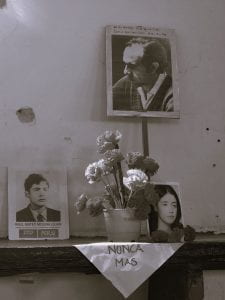I walked out of an exhibit room from where our group was, letting our guide Matias know that I’d be finding some place outside to sit and write my thoughts out. I nod through the kind-intentioned but ever-frequent “mire, este habla castellano” remark as I head through the doorway. The individual conversations of our group echo in cacophony as if to punctuate the dramatic shifts in sunlight and artwork that cover bare concrete walls.
The sun hits my face and I instinctually cover my eyes, realizing I’d look like a total jackass if anyone had been around to see it — I’d been wearing my cap backwards. I shift it to the front, and walk along the stamped-grass paths toward the asphalt road we came in on.
There’s a silence you would expect from this place if the only sense you could rely on was sight: the Sierras watch solemnly over these brushy, golden hills and plains as wispy cirrus clouds form overhead. The trees sway with the wind, and if you squinted your eyes, you could convince yourself you were at a dated summer camp.
The environment alludes to this place’s wrongness in a haunting duet with our guides. The rush of cars and trucks on the local highway joins with the screeches of flocks of loros, who make their homes in the “tall, but not tall enough” pine trees that line the road. The noise out here isn’t as comforting as I had hoped it would be, but I continue walking underneath the shade.
“We always come to where you expect us.”
I walked over to a smaller, closed-looking building near where we began the tour and noticed this painting — which we saw only a few days ago at the D2 by Plaza San Martin. I think I find it particularly striking because it’s one of the only instances we’ve seen portrayed so far of a reunion between someone desaparecide and their grandmother, but it’s only a painting.
Genocide is not forgiving. It is not a narrative-based phenomenon which follows a series of events that eventually allow for people to grieve and move on. Genocide begets maximum violence, and is disgusted by mercy. It demands inhumanity, and punishes those who still regard their captives as human.
Genocide is a machine that thrives off of a kind of “cultural inertia” — relying upon the frequency and scope of inhumane acts to simultaneously propel itself and define the world around itself. Anything that is not moving with similar speed and weight will be catastrophically consumed by the forces of genocide.
Genocide cultivates a society whose everyday implements are so closely aligned against its victims, that the nation’s systems and the methods of genocide cannot be differentiated. I read a sign at La Perla that said that “the dictatorship left, but its systems stayed”, and it makes me think of Atlanta. What’s the difference between living under slavery and living under Jim Crow if you’re a Black American in the South? If the “new” machine still targets the same exact victims, but gives its implements new euphemistic descriptors, how could we ever believe it to be different?
Gobodo-Madikizela (2008) speaks to to importance of incorporating the experiences of survivors into the dialogue of “what is to be done” following the events of genocide, particularly in South Africa. Without them, we cannot truly believe to serve their real interests — which, are to fundamentally to be heard and protected.
Crimes against humanity hide themselves in language as often the first, and most effective, way of creating cultural distance between victims and those who are not directly targeted. This semantic process encourages devils-advocates, cyclical and unproductive ontological analysis, and whitewashing to produce generations not only numb to, but disregarding of inhumanity. It creates citizens who are complacent so long as the violence ensures them luxury and comfort. It places the burden on the victim to cruelly and endlessly relive their traumas, to maintain a credibility that they never asked for. It creates networks of “sleeper-agent” sympathizers, who ordinarily believe themselves to be against such crimes yet would be inclined to commit them themselves given the opportunity.
I asked the universe, God, my ancestors — whoever would listen to me before I came here — to help me learn how to recognize when time is up, and to know the actions to take going forward.
Today taught me that time is up. I look to our elders to learn more, and to be ready.
CHALTV MAY KOM PU CHE KA MARICHIWEU








